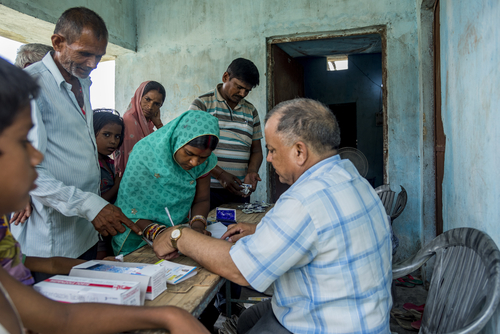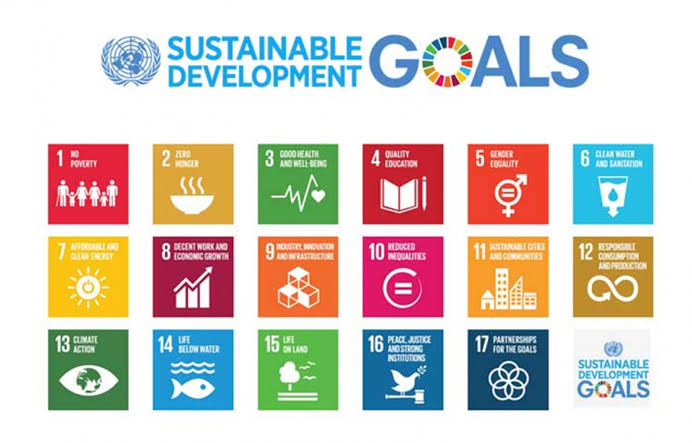The healthcare sector in India is one of the largest and fastest growing industries in India. In 2017, the industry stood at US$ 61.79 billion, and by 2023, it is expected to double by US$ 132.84 billion.
Yet, the Indian healthcare sector is in an ailing condition, as a majority of the investments do not reach the population that is in dire need.
The problem in India is, private hospitals provide excellent care but are beyond the reach of most people. And public hospitals are affordable but are overcrowded and lacks responsiveness.
While the government seems to be doing a lot by allocating a larger budget yearly, it is still far cry from what the country actually needs. In fact, India spends less than 2% of its GDP on healthcare, 1.4% to be exact, making it one of the lowest investors in the sector globally.

This is where investments from private sectors as Corporate Social Responsibility (CSR) in healthcare can make a big difference to society at large.
What’s the current trend in CSR for healthcare in India?
While healthcare does receive a significant amount of funds from the corporations, much of it is focused on health camps and building hospitals or upkeeping its facilities. All these solutions are merely temporary patches. The country needs solutions that will eradicate some of the fundamental problems.
1. Imbalance in infrastructure and population ration
Given the growing population of the country, the current infrastructure is greatly imbalanced. To the point that the doctor-patient ratio in India is 1:1700. This is dangerously low. Major investments in India primarily focused on urban centres while in rural areas are left with a bare minimum.
Under its ‘Comprehensive Healthcare Initiatives’, the NHPC Limited has been providing medical facilities, qualified doctors and medical attendants, in many rural areas of Assam. They also actively partner with government agencies in bringing awareness regarding many diseases.
2. Rural areas need more doctors
Besides infrastructure, the country is short of doctors, particularly in rural areas. While many companies are working in improving in this area, there still a huge gap that needs to be filled. People in rural areas need access to quality healthcare and the government can provide incentives to doctors to spend time in rural/remote areas and take healthcare where it is desperately needed.
Hindustan Petroleum Corporation Limited runs ‘Project Dhanwantari’ across the country. Through this project, they provide basic medical needs for people in remote rural areas by door-to-door with Mobile Medical Vans (MMVs).
3. Contribution to medical insurance
Quality healthcare for many is unaffordable in India. Rather than offering assistance with one-time or temporary treatments, companies could rather offer health insurance in a brand agnostic way, or tie up with pharma companies and provide cheaper medicines.
4. Focus more on mental illness
Support and awareness for mental illness are almost unheard of in rural areas. While the government offers very little support, many organizations like Infosys, TCS, and IDFC are taking up this cause slowly and even those are focused on urban areas only.
There is a lot that organizations can do to make quality healthcare available to all. There is a lot of money and a lot of intent too. All we need is proper channelling.
5. Reaching the unreachable
India is a country with more than 60% of the population living in rural areas and a low level of health facilities. Many villagers are forced to travel hundreds of kilometres to access basic medical treatments and follow up check-ups. In this case, telemedicine can be a great way to help these communities get the best treatment or diagnosis possible.

Parimal Enterprise, a pharma company, has taken up telemedicine as their corporate social responsibility to help the poor and rural households in remote areas. With their initiative like Dox-in-Box, Piramal’s telemedicine projects help people in remote areas access trained doctors. They have set up over 44 telehealth centres across the country, many in partnership with state governments. And help provide relevant information, screenings and follow-ups to patients.
6. Quality healthcare to remote areas
Rural healthcare is one of the biggest challenges the Health Ministry of India is facing. Though the government implementing a lot of policies and programs in trying to reach out to remote places, the effectiveness of these programs is questionable.
Wockhardt Foundation’s MOBILE1000 initiative is one program that has been spearheading in this area. Their aim is to provide free primary healthcare to poor Indians in rural India. With a fully equipped Mobile Health Van, an MBBS doctor and medicines providing ADCR (Awareness, Diagnosis, Cure, and Referral), they have helped over 171.47 lakh patients in different villages across the country.
7. Make India more healthy
India is known for having one of the largest populations of undernourished children in the world. So much so that even basic human rights are denied to millions, leading to stunted growth. Corporate houses can channelise their CSR fund towards building a healthy nation.
Dabur India’s ‘Nutrition Program’ is aimed at eradicating hunger, poverty and malnutrition through provision of food, nutrition supplement, clothes etc. Through this program, they have partnered with various government agencies and NGOs to supplement the nutrition needs of the poor and needy.

Health is a responsibility for one and all. For a country to be prosperous it requires its citizen to be in a healthy condition and think beyond basic survival. While the government is working on many projects, and a helpful hand from the corporate houses can make a huge difference.
 This is where investments from private sectors as Corporate Social Responsibility (CSR) in healthcare can make a big difference to society at large.
What’s the current trend in CSR for healthcare in India?
While healthcare does receive a significant amount of funds from the corporations, much of it is focused on health camps and building hospitals or upkeeping its facilities. All these solutions are merely temporary patches. The country needs solutions that will eradicate some of the fundamental problems.
1. Imbalance in infrastructure and population ration
Given the growing population of the country, the current infrastructure is greatly imbalanced. To the point that the doctor-patient ratio in India is 1:1700. This is dangerously low. Major investments in India primarily focused on urban centres while in rural areas are left with a bare minimum.
Under its ‘Comprehensive Healthcare Initiatives’, the NHPC Limited has been providing medical facilities, qualified doctors and medical attendants, in many rural areas of Assam. They also actively partner with government agencies in bringing awareness regarding many diseases.
2. Rural areas need more doctors
Besides infrastructure, the country is short of doctors, particularly in rural areas. While many companies are working in improving in this area, there still a huge gap that needs to be filled. People in rural areas need access to quality healthcare and the government can provide incentives to doctors to spend time in rural/remote areas and take healthcare where it is desperately needed.
Hindustan Petroleum Corporation Limited runs ‘Project Dhanwantari’ across the country. Through this project, they provide basic medical needs for people in remote rural areas by door-to-door with Mobile Medical Vans (MMVs).
3. Contribution to medical insurance
Quality healthcare for many is unaffordable in India. Rather than offering assistance with one-time or temporary treatments, companies could rather offer health insurance in a brand agnostic way, or tie up with pharma companies and provide cheaper medicines.
4. Focus more on mental illness
Support and awareness for mental illness are almost unheard of in rural areas. While the government offers very little support, many organizations like Infosys, TCS, and IDFC are taking up this cause slowly and even those are focused on urban areas only.
There is a lot that organizations can do to make quality healthcare available to all. There is a lot of money and a lot of intent too. All we need is proper channelling.
5. Reaching the unreachable
India is a country with more than 60% of the population living in rural areas and a low level of health facilities. Many villagers are forced to travel hundreds of kilometres to access basic medical treatments and follow up check-ups. In this case, telemedicine can be a great way to help these communities get the best treatment or diagnosis possible.
This is where investments from private sectors as Corporate Social Responsibility (CSR) in healthcare can make a big difference to society at large.
What’s the current trend in CSR for healthcare in India?
While healthcare does receive a significant amount of funds from the corporations, much of it is focused on health camps and building hospitals or upkeeping its facilities. All these solutions are merely temporary patches. The country needs solutions that will eradicate some of the fundamental problems.
1. Imbalance in infrastructure and population ration
Given the growing population of the country, the current infrastructure is greatly imbalanced. To the point that the doctor-patient ratio in India is 1:1700. This is dangerously low. Major investments in India primarily focused on urban centres while in rural areas are left with a bare minimum.
Under its ‘Comprehensive Healthcare Initiatives’, the NHPC Limited has been providing medical facilities, qualified doctors and medical attendants, in many rural areas of Assam. They also actively partner with government agencies in bringing awareness regarding many diseases.
2. Rural areas need more doctors
Besides infrastructure, the country is short of doctors, particularly in rural areas. While many companies are working in improving in this area, there still a huge gap that needs to be filled. People in rural areas need access to quality healthcare and the government can provide incentives to doctors to spend time in rural/remote areas and take healthcare where it is desperately needed.
Hindustan Petroleum Corporation Limited runs ‘Project Dhanwantari’ across the country. Through this project, they provide basic medical needs for people in remote rural areas by door-to-door with Mobile Medical Vans (MMVs).
3. Contribution to medical insurance
Quality healthcare for many is unaffordable in India. Rather than offering assistance with one-time or temporary treatments, companies could rather offer health insurance in a brand agnostic way, or tie up with pharma companies and provide cheaper medicines.
4. Focus more on mental illness
Support and awareness for mental illness are almost unheard of in rural areas. While the government offers very little support, many organizations like Infosys, TCS, and IDFC are taking up this cause slowly and even those are focused on urban areas only.
There is a lot that organizations can do to make quality healthcare available to all. There is a lot of money and a lot of intent too. All we need is proper channelling.
5. Reaching the unreachable
India is a country with more than 60% of the population living in rural areas and a low level of health facilities. Many villagers are forced to travel hundreds of kilometres to access basic medical treatments and follow up check-ups. In this case, telemedicine can be a great way to help these communities get the best treatment or diagnosis possible.
 Parimal Enterprise, a pharma company, has taken up telemedicine as their corporate social responsibility to help the poor and rural households in remote areas. With their initiative like Dox-in-Box, Piramal’s telemedicine projects help people in remote areas access trained doctors. They have set up over 44 telehealth centres across the country, many in partnership with state governments. And help provide relevant information, screenings and follow-ups to patients.
6. Quality healthcare to remote areas
Rural healthcare is one of the biggest challenges the Health Ministry of India is facing. Though the government implementing a lot of policies and programs in trying to reach out to remote places, the effectiveness of these programs is questionable.
Wockhardt Foundation’s MOBILE1000 initiative is one program that has been spearheading in this area. Their aim is to provide free primary healthcare to poor Indians in rural India. With a fully equipped Mobile Health Van, an MBBS doctor and medicines providing ADCR (Awareness, Diagnosis, Cure, and Referral), they have helped over 171.47 lakh patients in different villages across the country.
7. Make India more healthy
India is known for having one of the largest populations of undernourished children in the world. So much so that even basic human rights are denied to millions, leading to stunted growth. Corporate houses can channelise their CSR fund towards building a healthy nation.
Dabur India’s ‘Nutrition Program’ is aimed at eradicating hunger, poverty and malnutrition through provision of food, nutrition supplement, clothes etc. Through this program, they have partnered with various government agencies and NGOs to supplement the nutrition needs of the poor and needy.
Parimal Enterprise, a pharma company, has taken up telemedicine as their corporate social responsibility to help the poor and rural households in remote areas. With their initiative like Dox-in-Box, Piramal’s telemedicine projects help people in remote areas access trained doctors. They have set up over 44 telehealth centres across the country, many in partnership with state governments. And help provide relevant information, screenings and follow-ups to patients.
6. Quality healthcare to remote areas
Rural healthcare is one of the biggest challenges the Health Ministry of India is facing. Though the government implementing a lot of policies and programs in trying to reach out to remote places, the effectiveness of these programs is questionable.
Wockhardt Foundation’s MOBILE1000 initiative is one program that has been spearheading in this area. Their aim is to provide free primary healthcare to poor Indians in rural India. With a fully equipped Mobile Health Van, an MBBS doctor and medicines providing ADCR (Awareness, Diagnosis, Cure, and Referral), they have helped over 171.47 lakh patients in different villages across the country.
7. Make India more healthy
India is known for having one of the largest populations of undernourished children in the world. So much so that even basic human rights are denied to millions, leading to stunted growth. Corporate houses can channelise their CSR fund towards building a healthy nation.
Dabur India’s ‘Nutrition Program’ is aimed at eradicating hunger, poverty and malnutrition through provision of food, nutrition supplement, clothes etc. Through this program, they have partnered with various government agencies and NGOs to supplement the nutrition needs of the poor and needy.
 Health is a responsibility for one and all. For a country to be prosperous it requires its citizen to be in a healthy condition and think beyond basic survival. While the government is working on many projects, and a helpful hand from the corporate houses can make a huge difference.
Health is a responsibility for one and all. For a country to be prosperous it requires its citizen to be in a healthy condition and think beyond basic survival. While the government is working on many projects, and a helpful hand from the corporate houses can make a huge difference. 

 But, despite decades of reforms and government initiatives, a big chunk of the population remains uneducated. For reasons like lack of quality education, proper facilities, teacher quality, irrelevant curriculum, and pedagogy.
This is where India Inc can step in and help close the gap.
In fact, after implementation of the Section 135 of the Companies Act 2013, many organizations have indeed played their part. Corporate leaders have come to realize that the resources spent on education are bound to impact social equity. As a result, education has taken the lion’s share of their funding in their corporate social responsibility (CSR).
According to an analysis conducted by CSRBOX, over 88% companies in India invested CSR fund in one or more education projects. In fact, for the year 2019, 613 companies contributed to CSR through 8501 projects and a consolidated spending of INR 12143.77 Cr.
But, despite decades of reforms and government initiatives, a big chunk of the population remains uneducated. For reasons like lack of quality education, proper facilities, teacher quality, irrelevant curriculum, and pedagogy.
This is where India Inc can step in and help close the gap.
In fact, after implementation of the Section 135 of the Companies Act 2013, many organizations have indeed played their part. Corporate leaders have come to realize that the resources spent on education are bound to impact social equity. As a result, education has taken the lion’s share of their funding in their corporate social responsibility (CSR).
According to an analysis conducted by CSRBOX, over 88% companies in India invested CSR fund in one or more education projects. In fact, for the year 2019, 613 companies contributed to CSR through 8501 projects and a consolidated spending of INR 12143.77 Cr.
 3. Lack of maintenance
The CSR funds are usually spent on improving the basic infrastructure and amenities. However, there is a lack of continued maintenance, and due to that any development towards infrastructure only seems like a cosmetic change at best.
4. Lack of consensus on implementation
Lack of consensus is one of the main issues that local agencies face regarding CSR projects. This often results in duplication of activities by one or more corporates, which takes on a competitive spirit rather than a collaborative approach.
These are just a few areas of interventions that require immediate attention that corporates can focus their CSR on education. However, India Inc. has not forgotten that access to quality education is fundamental to the growth of India, and they are opening many windows of possibilities, where there were none. But with the right guidance and partnerships with government and other local agencies, they being to close the gap efficiently.
3. Lack of maintenance
The CSR funds are usually spent on improving the basic infrastructure and amenities. However, there is a lack of continued maintenance, and due to that any development towards infrastructure only seems like a cosmetic change at best.
4. Lack of consensus on implementation
Lack of consensus is one of the main issues that local agencies face regarding CSR projects. This often results in duplication of activities by one or more corporates, which takes on a competitive spirit rather than a collaborative approach.
These are just a few areas of interventions that require immediate attention that corporates can focus their CSR on education. However, India Inc. has not forgotten that access to quality education is fundamental to the growth of India, and they are opening many windows of possibilities, where there were none. But with the right guidance and partnerships with government and other local agencies, they being to close the gap efficiently.

 Corporate Social Responsibility (not necessarily the mandatory 2% spend under the Companies Act) plays a very vital role now more than ever. With the rampant spread of the Coronavirus, much like the spread that knows no borders or divisions, businesses are demanded to show loyalty to every stakeholder .
Identifying with CSR-equipped business – The ‘Was’ and ‘Is’
Was-
What earlier proved to be good for business was to meet the altruistic needs of goals that were worthy, to a society that was mostly working towards combining all the business and social goals.
Is-
While 2020 started off good, COVID-19 happened. So what IS, is a very different scenario that has to face long term and short term challenges created by this epidemic that leaves no business unaffected. Which is where learning the benefits of CSR plays a vital role now more than ever.
Corporate Social Responsibility (not necessarily the mandatory 2% spend under the Companies Act) plays a very vital role now more than ever. With the rampant spread of the Coronavirus, much like the spread that knows no borders or divisions, businesses are demanded to show loyalty to every stakeholder .
Identifying with CSR-equipped business – The ‘Was’ and ‘Is’
Was-
What earlier proved to be good for business was to meet the altruistic needs of goals that were worthy, to a society that was mostly working towards combining all the business and social goals.
Is-
While 2020 started off good, COVID-19 happened. So what IS, is a very different scenario that has to face long term and short term challenges created by this epidemic that leaves no business unaffected. Which is where learning the benefits of CSR plays a vital role now more than ever.
 While we focus on catering to our consumers, it is easy to let our staff slip our minds. But, CSR during COVID-19 demands a newer approach where employees benefit too. Start off by ensuring your employees’ safety and security, allowing them flexibility and lesser job-related stress. Extending your helping hand to ensure their mental safety as well is crucial too.
To keep your employees comfortable and ready-for-work in an environment that is new to both entities is by listening to them, just as you’d listen to your customers.
Support small business and give them a leg up. This will be a bucket of its own under CSR as across the nation, there are so many small businesses that have already been shut down and some of which have been capsized due to tumultuous waters. Some businesses are somehow managing to hold on and it takes good CSR to lift them up with the necessary funds that will keep them afloat.
While we focus on catering to our consumers, it is easy to let our staff slip our minds. But, CSR during COVID-19 demands a newer approach where employees benefit too. Start off by ensuring your employees’ safety and security, allowing them flexibility and lesser job-related stress. Extending your helping hand to ensure their mental safety as well is crucial too.
To keep your employees comfortable and ready-for-work in an environment that is new to both entities is by listening to them, just as you’d listen to your customers.
Support small business and give them a leg up. This will be a bucket of its own under CSR as across the nation, there are so many small businesses that have already been shut down and some of which have been capsized due to tumultuous waters. Some businesses are somehow managing to hold on and it takes good CSR to lift them up with the necessary funds that will keep them afloat.
 While it is important to self-promote and stay in the minds of people, it is also important to keep sensitivity in mind. People wouldn’t want to see you market your brand/business during these times whatever it be. So how do you find the balance?
Humanizing brands during a period of major dislocation
While It is important to let the world know what you are up against and how you are facing it, it is also important for us as people and as brands to address others with humanity, empathy and financial assistance to whoever needs it the most.
Stick to communicating about CSR via a single platform
Brands that blow their own horns are not the reassurance people are looking for. While the world falls apart, it doesn’t stand well to brand without humanity. Which is why branding about your socially responsible activities should be kept to the minimum and done with empathy, reminding people what we stand for during the most devastating change in the ways of the world. It is important to comfort them, yet remind them of the implications and the sustainable solutions.
While it is important to self-promote and stay in the minds of people, it is also important to keep sensitivity in mind. People wouldn’t want to see you market your brand/business during these times whatever it be. So how do you find the balance?
Humanizing brands during a period of major dislocation
While It is important to let the world know what you are up against and how you are facing it, it is also important for us as people and as brands to address others with humanity, empathy and financial assistance to whoever needs it the most.
Stick to communicating about CSR via a single platform
Brands that blow their own horns are not the reassurance people are looking for. While the world falls apart, it doesn’t stand well to brand without humanity. Which is why branding about your socially responsible activities should be kept to the minimum and done with empathy, reminding people what we stand for during the most devastating change in the ways of the world. It is important to comfort them, yet remind them of the implications and the sustainable solutions.
 REASSURANCE. The public feels like they are in safe hands when there is any form of reassurance. When someone reads a simple article about how a man fed the strays or fended for the downtrodden during a plight will uplift their spirit. But what comes with reassurance from a buisness of any size, is BRAND LOYALTY. And thus CSR can work on multiple levels for business of different sizes now more than ever.
Continue being patient, continue being a socially responsible business. And that means more than fulfilling the statutory obligations.
REASSURANCE. The public feels like they are in safe hands when there is any form of reassurance. When someone reads a simple article about how a man fed the strays or fended for the downtrodden during a plight will uplift their spirit. But what comes with reassurance from a buisness of any size, is BRAND LOYALTY. And thus CSR can work on multiple levels for business of different sizes now more than ever.
Continue being patient, continue being a socially responsible business. And that means more than fulfilling the statutory obligations. 









 While defining a purpose for the corporation, good corporate leaders seek to balance the broader societal interest with financial logic. The actions that they undertake are grounded in societal interests, irrespective of whether they are directly linked to the core functions of the business. So, instead of launching a pompous CSR program or throw in a few environmentally friendly policies, ask yourself some hard questions. What problem does my organization seeks to solve? How do we make people’s lives better? How can I get my customers and other stakeholders to be part of the purpose?
How is the sustainability of my Company related or contributing to the sustainability of the mankind itself?
Once you have a purpose that is shared by your customers and employees, you can take the relationship from merely transactional to a life-long one. It’s time for CEOs to take a lead on change rather than wait for government intervention – after all purpose means good business.
While defining a purpose for the corporation, good corporate leaders seek to balance the broader societal interest with financial logic. The actions that they undertake are grounded in societal interests, irrespective of whether they are directly linked to the core functions of the business. So, instead of launching a pompous CSR program or throw in a few environmentally friendly policies, ask yourself some hard questions. What problem does my organization seeks to solve? How do we make people’s lives better? How can I get my customers and other stakeholders to be part of the purpose?
How is the sustainability of my Company related or contributing to the sustainability of the mankind itself?
Once you have a purpose that is shared by your customers and employees, you can take the relationship from merely transactional to a life-long one. It’s time for CEOs to take a lead on change rather than wait for government intervention – after all purpose means good business.
 Hope this article provides an understand why a purpose-driven business is a necessity in today’s world. At
Hope this article provides an understand why a purpose-driven business is a necessity in today’s world. At 
 Indian laws related to CSR are also quite vague which also means that they are open for interpretation. For example, a number of companies transfer CSR funds to government programmes such as Prime Minister’s Relief Fund. This ends up becoming a one-time cheque signing exercise rather than proactive engagement with the community. Another issue has been non-compliance by firms primarily due to poor understanding of social needs of the society and lack of implementation capacity or expertise. In 2018, the government sanctioned prosecution proceedings against
Indian laws related to CSR are also quite vague which also means that they are open for interpretation. For example, a number of companies transfer CSR funds to government programmes such as Prime Minister’s Relief Fund. This ends up becoming a one-time cheque signing exercise rather than proactive engagement with the community. Another issue has been non-compliance by firms primarily due to poor understanding of social needs of the society and lack of implementation capacity or expertise. In 2018, the government sanctioned prosecution proceedings against 

 A CSR Assessment or CSR Impact Report, thus, is crucial to any CSR project and should include the ideas and feedback of all the stakeholders. This report should be reviewed on a regular basis and any changes should be documented so that the project implementation team is well aware of it.
Independent Assessments:
Third party assessment is another thing that the corporates can consider. This would help in proper evaluation of the company’s initiatives and the impact they have on society as a whole. An unbiased and independent organisation would always be a better judge of their CSR initiatives than an internal team. A third-party observer would not only look after the expenditure, but also deliver proper feedback ensuring the money is not spent in vain, and that company brings substantial changes to society.
Social Return on Investments (SROI)
Going a step ahead would be to undertake the social return on the amounts invested towards the various initiatives, projects & intervention. One needs to evaluate the SROI ratio for Intervention program to understand that for every rupee invested what is the social value created. Companies like Hindustan Unilever, Jindal Stainless Steel and Ambuja Cements, amongst others have published SROI Reports.
Image References:
https://upload.wikimedia.org/wikipedia/commons/4/46/Primary_Laos.jpg
https://upload.wikimedia.org/wikipedia/commons/thumb/6/63/Elementary_School.jpg/1280px-Elementary_School.jpg
A CSR Assessment or CSR Impact Report, thus, is crucial to any CSR project and should include the ideas and feedback of all the stakeholders. This report should be reviewed on a regular basis and any changes should be documented so that the project implementation team is well aware of it.
Independent Assessments:
Third party assessment is another thing that the corporates can consider. This would help in proper evaluation of the company’s initiatives and the impact they have on society as a whole. An unbiased and independent organisation would always be a better judge of their CSR initiatives than an internal team. A third-party observer would not only look after the expenditure, but also deliver proper feedback ensuring the money is not spent in vain, and that company brings substantial changes to society.
Social Return on Investments (SROI)
Going a step ahead would be to undertake the social return on the amounts invested towards the various initiatives, projects & intervention. One needs to evaluate the SROI ratio for Intervention program to understand that for every rupee invested what is the social value created. Companies like Hindustan Unilever, Jindal Stainless Steel and Ambuja Cements, amongst others have published SROI Reports.
Image References:
https://upload.wikimedia.org/wikipedia/commons/4/46/Primary_Laos.jpg
https://upload.wikimedia.org/wikipedia/commons/thumb/6/63/Elementary_School.jpg/1280px-Elementary_School.jpg 
 Why A Company Should Produce A CSR Report?
Why A Company Should Produce A CSR Report?